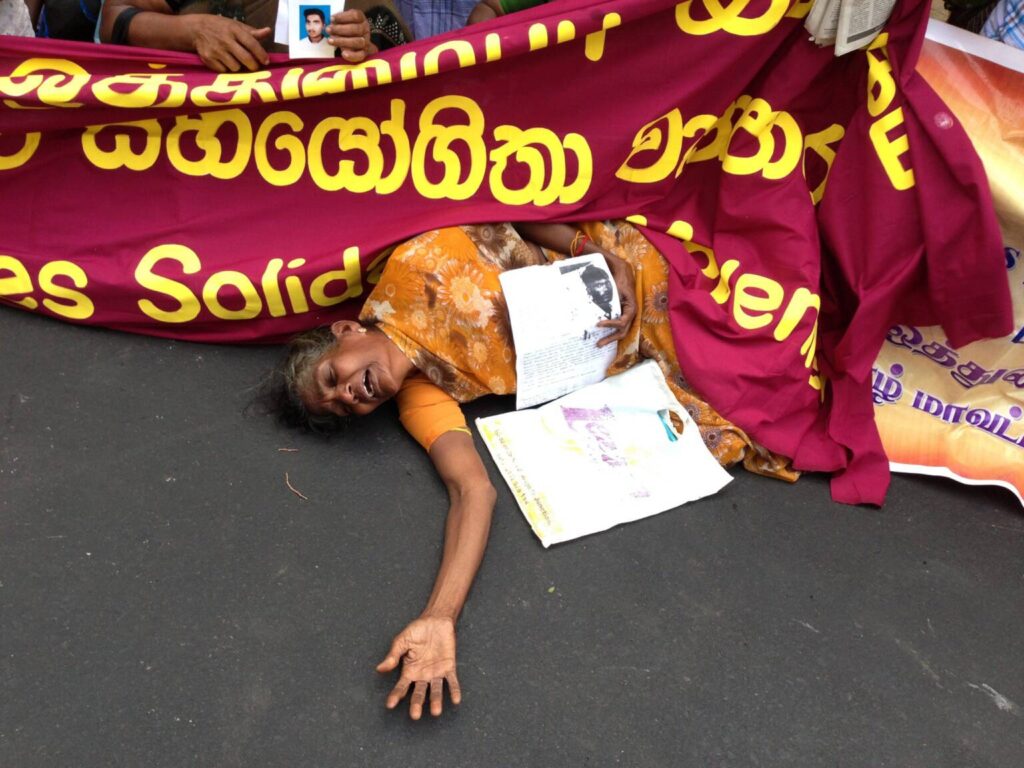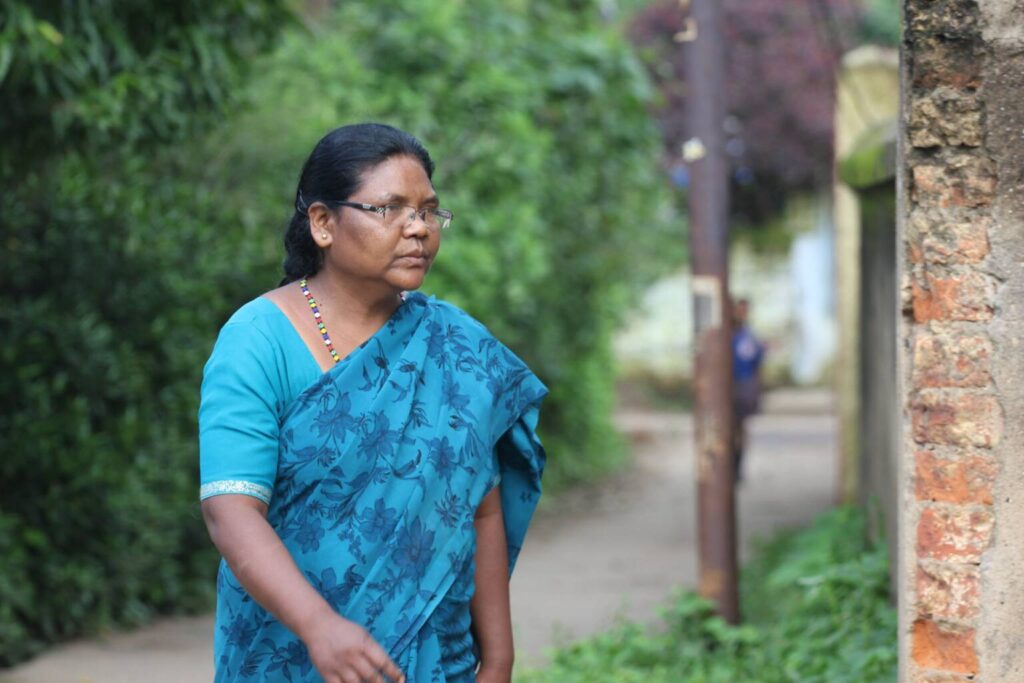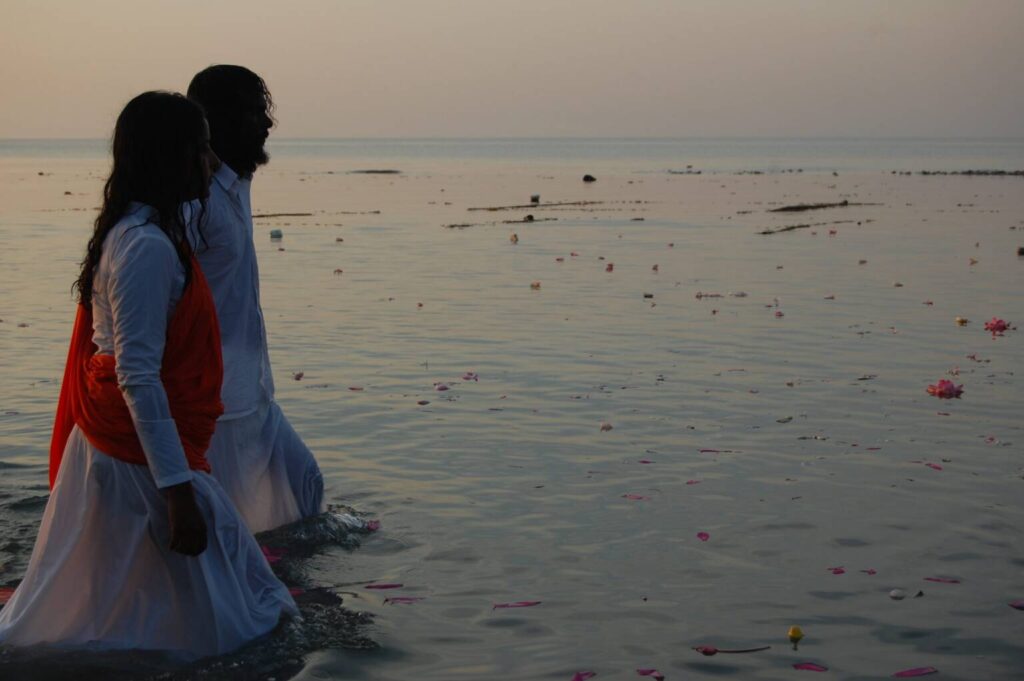The Unknown Fate Of Thousands In Sri Lanka
Link in Kafila
http://kafila.org/2013/09/02/the-unknown-fate-of-thousands-in-sri-lanka-leena-manimekalai/
Link in

https://www.colombotelegraph.com/index.php/the-unknown-fate-of-thousands-in-sri-lanka/
By Leena Manimekalai –

Leena Manimekalai
By the wayside: This wreath/ with no name attached /is for you/who has no grave/ As the place of earth/ which embraced you/ could not be found/this wreath was placed by the wayside/Forgive me/ for placing a memorial for you/ by the roadside
writes Basil Fernando about the memorial constructed by families of disappeared at Radoluwa Junction in Seeduwa, a town near the city of Negombo, Srilanka. When I visited the memorial with lingering faces of the disappeared, it signified an important attempt to keep the memories alive, a yearning to prevent recurrence of mass disappearances and seek justice on behalf of the victims of disappearances and their families. Sri Lanka which has a deep and complex history of political violence is struggling to redeem the past with a frozen present and a black hole future. Communal riots, political assassinations and ethnic conflict have been an element of the socio political landscape of this tear nation for more than a century. Two heads of State, dozen national political leaders and numerous regional and local politicians, journalists, activists and artists have been assassinated by groups representing virtually every shade of political spectrum. Srilankan State deploys disappearances and extra judicial killings as an instrument of public policy in the name of State Emergencies, Prevention of Terrorism Act, Dubbing of persons as terrorists, unpatriotic, enemies of state. Brutal suppressions of two armed insurrections in the Sinhala South in 1971-72, 1987-89 led by Peoples Liberation Front (JVP) and an armed Tamil Separatist Movement since 1970s led by the Liberation Tigers of Tamil Eelam(LTTE) in the Tamil North and East of the island had spotted Srilankan State guilty of horrific human rights abuses. Now the Nation is the world leader in number of disappeared crossing tens of thousands who have no date of death, no place of death, no body, and no grave or funeral rites. Obviously there is no shelling, no bombing in the island since 2009 and the State wants the world to believe that war is over but who will bring peace to the families who continue to lose their members to State Terror and also been denied their basic right to even open their mouth about the injustice.
What do you demand your government regarding your missing son? I asked Ilangairathinam of Iranapalai village near Mullivaickal, who is the mother of four children and whose elder son is missing since 2009. Her husband is paralysed by the shelling during the last phase of war in 2009 and she carries a piece of a bombshell in her chest, which is medically impossible to remove. Her daughter’s school got interrupted because of war and lack of finances did not let her continue. One of her son’s legs is amputated out of a shell attack and the other son is reportedly abnormal in his mental status, post war. Apparently the family lives in rambles with small maintenance money given by the government and the daily wages the mother is able to earn out of a cook’s job in the local school. She did not answer my question and gave me a cold look. I was clueless. My question might have been ridiculous in the hapless state she is currently in. Her son was forcefully recruited by LTTE in 2008 and sent to the warfront, where he ultimately surrendered to the army and there is no news after that. Mother is been searching all the detention camps and prisons and check posts and NGO offices and police stations and state offices since her family relocated to their village after the horrendous displacement route from Iranapalai to Mullivaickal to Nandhikadal and then to Vavuniya camps since December 2008 for almost a year. Did her smile indicate the terror she is still captivated with, that never left her even after all these years? Or did she think that asking the government for anything was a useless exercise? Or she has lost hope in anything and everything? Or she wondered what will bring her by sharing her story with me?
I have read about disappearances, forced abductions, white van stories, detentions, killing and torture and my knowledge about it is only through news reports, literature and articles. My visit to the monument of the disappeared started haunting me and I had a strong calling on knowing more about the stories behind the photographs. I wondered who want their loved ones to be a bronze or marble plaque at the end of the day. I had night mares about the trauma of mothers they would go through every day with all the wildest imaginations about their sons and daughters in camps and prisons or such dodgy places. I was intrigued to know how it is like for the families of the disappeared to lose a loved one under such horrendous circumstances. I wanted to know their fears, thoughts and their dreams of hope.
Vini, the mother of five children in Pesalai, Mannar sold the boat her husband had owned, to meet up with her emergency financial needs. She has no clues about why her husband was forcefully taken by Army in front of her eyes and whole family and people in the village being witness to it. She insists to show her, her husband and she doesn’t mind even if he is in prison undergoing the cruellest of punishments. She just wants to know if he is alive. She is struggling hard to save her sanity amidst newspaper reports about floating bodies of the disappeared down rivers, laid upon roads, burnt with tyres, exhibited beheaded in public, naked with bottles in their genitals and similar gruesome acts. Her children live with the barest of essentials and her inability to feed her children three meals is the most humiliating emotion she goes through. As the interview transpired, I could see how determined is she to have her husband alive in her memories and continue to believe that they will be reunited soon. Her eldest daughter showing symptoms of withdrawal and mental depression never leaves her room, while the second to elder most daughters has written notebooks of letters to her missing father. Vini has stopped her teenage son from school, fearing of any abduction. She comes across the navy officials who took his husband away, every day in her village sentry points but they neither reveal any news nor engage legal complaints.
While the fate of the highest leadership of LTTE who surrendered in the last phase of the war faced the worst war crimes by the army such as brutal mass murders , few of the second level leadership detained in prison are found missing while in custody. Worst affected are the low level LTTE cadres. Immediately after the war ended in May 2009, the government began announcing in the IDP camps that anyone who had spent “even a minute” with the LTTE should surrender themselves to the Army. Fearing that worse would happen to them if they refused to surrender and were found out later, 11,982 Tamils surrendered. These were the ones who underwent worst of torture, disappearances and extra judicial killings. I met mothers and sisters of some young people who were forcibly recruited and spent only a few days or months with the LTTE were arbitrarily detained and found missing or reported brutally dead later in the newspapers. There were several other stories of individuals disappearing who had no field participation, but had been forced to work for a few months in the kitchen or building bunkers who then surrendered to army. Mothers from Mannar to Mullaitheevu, the area boxed in 2009 for ethnic cleansing repeatedly told me that, when the government detains their sons and daughters who were low-level cadres while reintegrating some of the LTTE’s most prominent leadership, it serves as a double betrayal – first, by the LTTE who forced civilians to fight for them, and second, by the government who is punishing those very same civilians with lengthy detentions and sham trials.
Initially, I was worried about my whole attempt of meeting and interviewing people will be prying into painful memories. I was repeatedly cautioned that some of the families were wary of revealing information and sharing their story as they were still afraid. But I was moved by the warm welcome and smiles. I was offered tea and biscuits and it looked so alright with their welcoming gestures. But the moment, I started asking questions, there will be killing silence. Suddenly darkness creep in like it will swallow everyone and everything around. Then they will slowly unravel about their sleepless nights, mental agony and endless journeys in search of a son, daughter, husband, father or a brother. The heart wrenching voices I heard made me weep for hours and their tears swell in my memories. Though few of them openly admitted that having a heart pour helps their healing, I was awed by the sense of trust they develop with strangers like me while there is utter mistrust been built by the dirty war and aftermath, even with their own folks and neighbours. When a mother showed lungis and the purse of his son preserved in a box while they do not even have a roof to live under and when a mother shared with me how she still serves food in her daughter’s plate while serving meal to her family and when I met a father who became clinically obsessed with astrology spending all his time tracing his daughter, I could not stop myself shivering to the pages of deepest human emotions.
When I pursued with my questions on why religious and civil society leaders are silent about this human trial, I came to know that they met the same fate as that of the disappeared whenever they dared to speak out. Most of the affected do not know where to go and whom to ask justice when the State itself has given a free rein to the custodians of law to break the law. But still few of the families dared to appeal and fight their legal struggles. And they have their due of enforcement officials often visiting them, forcing them to accept death certificates and some paltry compensation. Families said they could not assess the value of their loved one in monetary terms and I met a mother who refused to accept certificate and money but demanded her right to the corpse of her son to fulfil the last rites. My understanding is disappearances caused by state sponsorship are the most difficult human right violation forms in getting redress. Impunity would be the order of the day when the State itself is involved in these heinous crimes.
My deepest experience is the day I spent with the mothers and fathers of the dead found in Mathalai Mass graves, discovered during last December(2012) with 115 bodies. Forensic reports declared that the bodies belong to the year 1989 to 1991. Families, searching for their wards who were believed disappearing for decades together, now appeal in the courts to find out if the mass graves had their sons or daughter’s dead bodies. As I had mentioned earlier, large scale mass murders were made in the late eighties and the disappearances were explained as a consequence of a civil conflict between a group of insurgents known as Janatha Vimukthi Peramuna(JVP) or People Liberation Front and the security forces. JVP was declared one of the instigators of the July 1983 riots against Tamils in the north(while the gravest 83 riots was a state sponsored pogram against Tamils) and is been forced underground and hunted down by what is called as State’s war against dissent. Irony is Sinhala JVP in the south and the Tamil LTTE in the north and east developed modes of brutal retaliations in terms of militancy. So, the State used it in its propaganda to disguise the extensive violence perpetrated by State in crushing them. And all the time, civilians were bombed, killed and butchered in the process. Fact is, in the name of dealing militancy, the Executive President of the State whoever held the position erased political opposition through the years with the help of draconian laws and military powers resulting in an unquestionable authoritarian regime. When I discussed with intellectuals who are still left alive in the island, they spared that the truth is in Lanka, there is no conceptual framework existing to resolve any of the major issues, including the issue of ethnicity. And looking for an isolated solution to the ethnic crisis is a constitutional illusion and the tragedy is that people paid in blood in life in history for such illusions.
The grim fact is number of disappearances in Lanka according to official records is nearing thirty thousands and out of this 15 percent are below the age of 19. Sadly many families today believe that the disappearances would continue in the island. The politicians, army officers and policemen who are responsible for the disappearances starting from 1980’s are still politicians with more power and the army officers and police now hold more powerful posts than the posts they held before. And the fear psyche still encompasses the landscape. War is still alive and kicking in the form of silencing and militarisation. Listening to stories of suffering, it is easy for anyone to lose hope in humanity. Families of the disappeared have remembered those no longer with them by seeking to reform a system rooted in violence, impunity and fear that robbed them forever of their loved ones. Their pain can never be erased but that’s the very important one to be transferred to the hearts of every decent citizen who can act against the State executing the gravest of crimes. At some stage national and international conscience, if there is such thing remaining, should prove capable of responding to their pain. I was in Jaffna when families of the disappeared gathered on July 27th behind Jaffna Library, craving Ms. Navi Pillai , the UN Human Rights High Commissioner’s attention. I was lost in tears and I felt my camera so powerless before the portraits of the missing mothers and fathers and sisters and brothers and sons and daughters, their beloved were holding as deepest wounds caught in between frames. Ms. Navi Pillay did not meet them in Jaffna but in Colombo subsequently on august 30th. I sighed when I heard her saying “It is important everyone realizes that, although the fighting is over, the suffering is not. I have been extremely moved by the profound trauma I have seen among the relatives of the missing and the dead, and the war survivors, in all the places I have visited, as well as by their resilience. Wounds will not heal and reconciliation will not happen, without respect for those who grieve, and remembrance for the tens of thousands of Tamils, Sinhalese, Muslims and others who have been missing in the battlefield, in buses, on the street, in detention, or by forced abduction”
*Leena Manimekalai – Filmmaker, Poet could be reached at leenamanimekalai@gmail.com
A Ballad of Resistance: An evening with feminist film-maker, Leena Manimekalai
Links : http://womensearthalliance.blogspot.in/2013/06/a-ballad-of-resistance-evening-with.html
By Lauren Bellenie, WEA General Intern
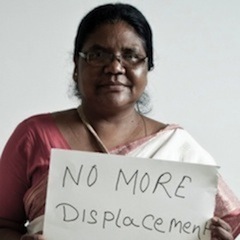
Dayamani Barla was jailed last year to silence her anti-displacement activism.
On June 18th, friends of WEA, old and new, trickled into the David Brower Center to meet a special guest speaker, Indian social justice film-maker, poet and actress, Leena Manimekalai. Rucha Chitnis, WEA’s South Asia Program Director, welcomed everyone to the event and shared how indigenous women were on the frontlines of global resistance against landgrabs that threatened their ancestral homelands, and how films, such as Leena’s “Ballad of Resistance”, are an important vehicle to highlight the crucial role women play in social movements and defending human rights.
Guest speaker, Preeti Mangala Sekar, ED of Narika, read a poem written by Leena called “Penalty.” The poem framed the public response to Leena’s poetry, including demands from some right wing voices, who shunned it as “pornographic” writing. The poem’s content highlighted the feelings and situations that arise when the only path to follow is one that is honest, yet perceived by some as inflammatory because it expresses and asserts female sexuality and power. Leena relates to this through her own unconventional life path and through the stories of human rights activists, especially women, that she documents in her films.
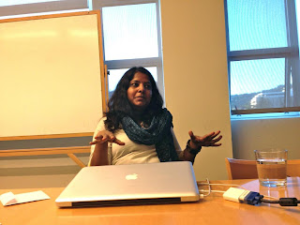
Leena sharing about her personal journey as a feminist film-maker
Leena screened “Ballad of Resistance”, which follows Dayamani Barla, India’s first indigenous female journalist from Jharkhand, who has centered her life on protecting ancestral lands occupied by tribal communities in her state. “Ballad of Resistance” offers a breath-taking view into the longterm social action against the external pressures of development facing indigenous communities in India. The film shows how Dayamani works tirelessly at the grassroots, documenting the struggle through her journalism and efforts to organize tribal communities to stand strong against corporate landgrabs for mining and other industrial development projects.
Dayamani explains in the film that the Munda tribe has been resilient to many attempted impositions over the years. She notes that this area represented resistance against British colonizers, long before the time of Gandhi. Though the fights have not always been easy, their persistence has afforded them their land rights on multiple occasions. Today, women are on the frontlines of these movements against land grabs from powerful forces. One moving scene in the film showed women from Nagri communities tearing down walls of government-santioned construction sites to make way for business and law schools, despite police presence. The women featured in the film echoed the sentiment, “We will give our lives but not our land.” Dayamani stands for the dignity, rights and identity of her community and the ancestry that constitutes the foundation for their relationship with “Mother Nature”.
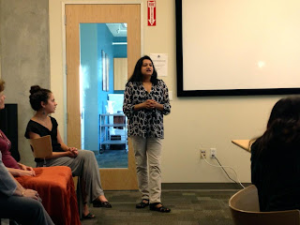
Anu Mandavilli introduces Leena
Throughout the evening, the audience gained fascinating insights into Leena’s own life as a feminist artist and activist. During the question and answer portion, Leena shared how she began making films to document lives of people, who are left out of mainstream media and development processes. She explained that she would go to communities and document their story of oppression, and then the oppressors of that group would also want her to document their story as well.
Leena’s films are creative and effective means to highlight human rights violations, as well as the agency of local communities to demand justice and dignity. When Dayamani was arrested in 2012 for two and a half months, supporters used Leena’s film as a means to raise awareness to free her. Attendees were so engaged in the discussion with Leena that it continued well past the scheduled finish time.
Leena closed with a statement about our role in these issues as international allies. She encouraged our role as funders, given the sparse monetary sources available for NGOs and social movements in India and profoundly stated that “Indian resistance is at a challenging point, but we can give them hope and solidarity that they are not alone.”
Special thanks to activist, Anu Mandavilli and Friends of South Asia for partnering with WEA to host this gathering.
Of dead seas and Indian independent films – Bollywood
Mumbai: “Whether we see our wives or not, we see a dead body every day,” complains a policeman inspecting the body of a fisherman who has been shot at sea by the Sri Lankan Navy. That one line in Leena Manimekalai’s film ‘Sengadal’ (‘The Dead Sea’), the only Indian film in the international competition in the just-concluded Mumbai Film Festival, seems to sum up not just this movie, but Indian films in general.
Whether you see good cinema in India or not, you invariably get to see tactless blockbusters every Friday, could be a common complaint of any cinema fan in India.
And nowhere is this metaphoric example more evident than in Manimekalai’s film, which from many perspectives, like technical aspects and even scripting may not be one that is up there, but there is no denying that this is an important film that needed to be made.
“Sixty percent of the film was illegally shot. We had to resort to guerilla style of filmmaking to finish it,” Manimekalai’s told IANS.
‘The Dead Sea’ is a tale of Sri Lankan Tamils fleeing to India, only to face persecution here.
Secondly, the fishermen community of Rameshwaram who venture out to sea, are blatantly shot, beaten and in a few cases, have even sexually assaulted by the Sri Lankan Navy for no apparent reason. They also do not get much support from the Indian authorities. With over 600 dead or missing fishermen, it is an extreme example of living in the fringes.
Manimekalai wanted to show an honest story. Hence you have real people almost playing themselves and their lives to the T. The result is a film that may be far from cinematic accomplishment, but the one accusation that cannot be levied on it is of being dishonest.
If you were to see footages of film stars, you’d obviously want them in HD. Yet on the same TV, you don’t mind the grainy images of a terrible atrocity that makes breaking news. In that light, ‘The Dead Sea’, that gives voice to the most marginalised of the marginalized lot, becomes an extremely important film.
In an ideal world, it would have enjoyed better resources. But neither has the film been made in an ideal world, nor is Indian cinema in a similar state with most film made and released only solely commercial intentions.
Yet, this year’s Mumbai Film Festival provided an interesting contrast and an example of where Indian cinema is headed. Around 15 percent of films in the festival were Indian. They were put in three sections ‘Indian Frame’, ‘New Faces In Indian Cinema’ and ‘Film India Worldwide’.
The range of films in these sections reflected the variety of films which sadly, like the fishermen in the film, lie on the fringes of Bollywood.
Despite receiving rave reviews from festival viewers, the fate of most of these films are doubtful, just like the fishermen in ‘The Dead Sea’.
“The fishermen of this community on which this film is based, are facing extinction,” says Manimekalai. One hope this is not the case with these independent films.
(For updates you can share with your friends, follow IBNLive on Facebook, Twitter and Google+)
A Conversation about Sengadal – Rediff.com
http://www.rediff.com/movies/slide-show/slide-show-1-south-interview-with-leena-manimekalai/20111230.htm
Last updated on: December 30, 2011 13:56 IST
Shobha Warrier in Chennai
The average cinemagoer in Tamil Nadu might not even have heard of a film called Sengadal –The Dead Sea.
But the film was the only Tamil entry at the International Film Festival of India in Goa this year.
It has also won several international awards. More than a film, it is a political statement by Leena Manimekalai, an engineer-turned-filmmaker. The film is about the sufferings of fishermen caught in the Sri Lankan ethnic crisis.
Though Sengadal is her first feature film, Manimekalai has made 10 documentaries and won several awards at various international film festivals and has just been selected for the Charles Wallace Fellowship.
Before leaving for London for the fellowship programme on documentary film-making, Manimekalai spoke to Shobha Warrier on how Sengadal was made and received.
What was the inspiration behind Sengadal? Is it the culmination of all the documentaries you have made so far?
As I come from a political family of Communists, I was directly and indirectly involved with the Sri Lankan crisis throughout my youth. I was part of a group that was involved in the anti-war movement and India’s stance in the war. Documentary filmmaking was an extension of my activism.
In 2009, the ethnic crisis in Sri Lanka was at its peak. The air you smelt and the noise you heard were filled with human cries. I could not but get involved in it more directly. That was how I got involved with the fishermen’s movement. The stories the fishermen and women from the Rameswaram area shared with me were horrifying. Every household had lost at least one person to the sea.
I wanted to convey through the film that they wanted to live in peace and be treated like human beings. My film is a documentation of the time from January to May 2009.

Did the line between documentary and feature film blur while making Sengadal?
You may wonder whether it is real or captured. That is very intentionally done. I wanted to capture the lives of those people and whatever tools helped me as a filmmaker, I used them.
Did you use real people in the film?
Yes, there were no actors in my film; all are real people. It is actually a community participatory work.
Why do you then call it a feature film, and not a documentary?
Because it is not a documentary. I had made 10 documentaries before, and I would call a documentary, a documentary. This film is based on a bound script. I only used real people to act in my film, that’s all. We had a series of workshops to teach them how to act in front of the camera.
Image: A scene from Sengadal

What kind of ground work did you do before you started making the film?
It took six months of research and 100 hours of sharing their stories. I interviewed hundreds of fishermen and women, police officials, intelligence officials. Through NGOs, I visited refugee camps.
How difficult was it?
It was very difficult, as difficult as the fishermen’s lives. There is a meta-fiction of a filmmaker in the film. A filmmaker is trying to film the fishermen’s lives and she gets constantly interrogated and harassed, her tapes were confiscated and she fails to make the film.
But you made the film…
It almost happened with me. Every time I went to do research, I was stopped by the Navy, police, etc. I only had the love and trust of the fishermen and nothing else. That’s from where I gained courage and it saved me from many critical issues.
It was a community participatory work. Every scene and dialogue was drawn from their lives. When we were shooting in the sea and when a Navy plane flew over us, the fishermen hid us film-makers under a net.
Image: A scene from Sengadal

Why did you call the film Sengadal which means ‘red sea’? Is it symbolic of the blood that has become part of the sea?
It is a Biblical allusion. In the Bible, it is the Red Sea, but I gave it the meaning of Dead Sea or Sava kadal, the sea that kills people. It is like Moses helping his people cross the sea. Here, the Tamil fishermen cross the sea to India hoping for a better life but the situation is worse here.
There is a dialogue in the film that the refugee camps are no better than an Army camp. The camps smell of dead bodies and there are crows, vultures, and dogs vying for the dead bodies. Death is in the air.
There is also the possibility of interpreting it as the sea filled with the blood of fishermen.
You had a lot of problems with the Censor Board.
I had problems with the producers too. Film director Samuthirakani was the producer initially. But he withdrew after six days of shooting as there was a conflict between independent film-making and people from the industry.
But I could not stop shooting. So, I begged all the people I knew, my friends and relatives, to contribute. After 11 days of shooting, there was no money and we stopped shooting and came back to Chennai.
I showed whatever we had shot to many people, including Janaki Sivakumar, wife of the chief engineer at A R Rahman’s studio. She helped me by collecting money and becoming the producer. I did the rest of the shooting with her support.
It took me another seven to eight months to complete the post-production work. It was only ready in January 2011.
When I took the first copy to the Censor Board they said the film was not qualified to be exhibited in public for three reasons: it makes denigrating statements about the Indian government, about the functioning of the Sri Lankan government, and the dialect of the fishermen is unparliamentary.
I went to the Appellate Tribunal. They asked the Central Board of Film Certification to re-examine the film. Leela Samson became the head of CBFC by then and the film was given a certificate without any cuts but with an A certificate. I had to negotiate the corridors of power single-handed.
Image: A scene from Sengadal

After that, Sengadal went to quite a few international film festivals and won awards too…
It was premiered in the official competition at the 32nd Durban International Film Festival. Then, it was the official selection for the First Film Competition at the 35th World Montreal Film Festival. It won the NWAFF Award at the Tokyo International Women’s Film Festival.
In the International Competition at the Mumbai Film Fest, MAMI, Sengadal was the only Indian film. At the International Fishermen’s film festival in France, it was the opening film. They have subtitled it in French.
What was your feeling when it was selected as the only Tamil film in the Indian Panorama at the IFFI, Goa?
It was a pleasant surprise, because it is a political film and is very critical of the Indian government. And the Indian government choosing it as the best Tamil film gives you hope that there is democracy in this country. It gives you a huge hope that the lives of fishermen, treated as of no value, is after all important.
Image: A scene from Sengadal

How was the response in Goa?
Tremendous. More than that, this film has given me space to talk about the issue. Fishermen on all the borders in the world face the same plight.
How did the Tamil film industry react to your film?
This is how they reacted: at the Chennai Film Festival, all the films shown in the Indian Panorama at Goa were shown, except Sengadal. They were scared because it talks politics directly. There was censorship at the festival, which angered me.
Film festivals generally show provocative films. It’s a place where you can breathe freedom. So, on the opening day, I protested. After the protest, it was shown.
When do you plan to release the film?
I plan to release it on the Internet where there are no powerbrokers like the distributors and theatre owners in between. I can then market it in the social media.
Image: A scene from Sengadal
No holds barred – Interview in The Hindu
SUDHISH KAMATH
LIFE & STYLE » METROPLUS CHENNAI, December 29, 2011
The HinduFiery Filmmaker Leena Manimekalai Photo: Thulasi Kakkat
RE-IN


Brutally honest and emotionally raw, Leena Manimekalai speaks about her controversial and acclaimed film ‘Sengadal’ and her life’s many missions
She has constantly taken the side of the oppressed, fought the system, gone against the tide and continues to rebel, mincing no words to express what she feels. Brutally honest, emotionally raw and naturally poetic, 30-something independent filmmaker Leena Manimekalai is a real-life heroine battling the odds to fight for her artistic freedom and a passionate activist whose heart bleeds for her people.
Her tenth film “Sengadal — The Dead Sea”, also her debut feature, a docudrama on the plight of the fishermen community in Dhanushkodi who are caught between the devil and the deep sea for their survival, has created quite some buzz at the recent film festivals in Mumbai, Goa, Kerala and Chennai after winning a battle with censors.
One would assume that she feels vindicated and relaxed given the reception to “Sengadal” but ask her if her faith in the State is restored and she shoots back: “When you see the tooth of the lion, can you think it is smiling at you? I was born here. I vote every year and pay taxes. But this does not mean that the State can dictate or control my artistic expression. As a poet and a filmmaker I have been suffering hurdles in the way of free expression,” says Leena.
But the fact that “Sengadal” was chosen for the Indian Panorama section of the International Film Festival of India and the international competition at MAMI and the World Cinema section at the International Film Festival of Kerala gives her hope and has boosted her morale.
“What worries me is the politics of control working behind the system but I detest censorship of any form, constitutional or extra constitutional, as an artiste. Censorship is like mutilating my body organs.”
“Sengadal” has also been internationally acclaimed. “NAWFF Award at Tokyo, Montreal and Durban International Festivals and some ten more invitations for competitions at various International film festivals gives me a hope that I can aspire to do that one good film before I die.”
Given the rebel she has been all her life, has she ever felt patriotic? “No”, she says. “Don’t you think identities are a cross to carry? A woman, a Tamil, an Indian, an independent artiste, a Leftist all are thrust upon me. All these identities create borders and make us refugees or eligible citizens according to their lawbooks. How I wish I were a bamboo in a wild forest plucked by a musician to be sculpted as a flute.”
“A refugee will know what it means to have a country of his or her own. I feel I am from this ancient village stone weathered by kingdoms, occupations, colonial rulers, wars, emergencies, democracies but still immortal. An MNC may come and install a McDonald in my village but I will eat honey from my backyard. I am from that village the surveyor skipped to map on the atlas. And, of course, I will continue to vote for our democracy to mature, pay taxes and hold an Indian passport.”
She vents her angst through her art. “I am not loyal to any establishment. I challenge and betray my race, religion, caste, gender and everything encrypted on my existence and am a traitor in that sense. Fortunately I learnt to write — writing keeps me sane and non-violent. But I consider my own language as my first enemy. Like a blurb on one of my poetry anthology says: ‘History is pornography and I am its star’.”
Early influences
“I was born to a farmer mother and a Tamil professor father. My cradle was tied to the neem trees of the Western Ghats and I am this typical Kurinji (hills) woman. All my intensity is dedicated to the mangoes and the torching sun of my village. And my passions are drawn from the wild rivers and heroic stories of my village deities. Still my fore mothers hold my spirits and my fore fathers spell my knowledge. I owe my political existence to my readings on E.V.R. ‘Periyar’ and Marx. Ambedkar is one whom I yearn to master before my life term and I continue to draw inspirations from the whole ‘She’ gang.” And Leena lists them all — “Kamala Das, Mahashweta Devi, Andal, Rosa Luxemberg, Alexandra Kollantai, Sylvia Plath, Judith Butler, Arundhati Roy, Kathy Acker, Maya Deren, Agnes Varda, Sofia Coppola, Simone De Beauvoir, Frida Kahlo, Catherine Breillat and so many women who have lived fearless lives.”
On politics and criticism
Does it hurt her if “Sengadal” is criticised as a one-sided emotional propaganda film? “It is a simple depiction of our Tamil fishermen’s ability to live in the border shores of India and Sri Lanka amidst violence and oppression. It is about a failure of a filmmaker to make an impossible film. ‘Sengadal’ is about a lost dream of the Tamils of Sri Lanka to own their piece of land. It is people participatory work and not an author’s cinema, not perfectly made and never completed,” she says.
“When a film deals with current politics, it is immediately seen as some loud, explicit work. It is as delicate and complex and challenging for an artiste to handle politics around contemporary times. And the amount of energy you end up spending in activism than making the film itself is way too much and people should understand making an independent personal film in this country is actually a suicide attempt.”
Leena doesn’t let any of that come in her quest for perfection. As she completes work on her poetry film “My Mirror is the Door”, her tribute to the women poets of the Sangam era, she leaves for London next week as a Charles Wallace Scholar at the School of Oriental and African Studies. She has a couple of other scripts and is also working on “Passport”, written by Shobasakthi that she plans to pitch to producers. “Hope my cloud rains and there’s a harvest.”

